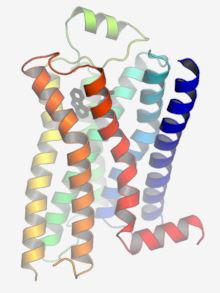Introduction of GPR12
Encoded by GPR12 gene, GPR12 belongs to the G-protein-coupled receptor (GPCR) family, which comprises a large protein family of transmembrane receptors. GPCRs play central roles in neuronal control of body functions, neuronal differentiation, neuronal growth and formation of synaptic contacts. Similar to other GPRs, GPR12 also has seven transmembrane domains constituted with α-helix. The third domain is highly conservative revealing the important function of stability maintenance and receptor activation.
| Basic Information of GPR12 | |
| Protein Name | G-protein coupled receptor 12 |
| Gene Name | GPR12 |
| Aliases | NA |
| Organism | Homo sapiens (Human) |
| UniProt ID | P47775 |
| Transmembrane Times | 7 |
| Length (aa) | 334 |
| Sequence | MNEDLKVNLSGLPRDYLDAAAAENISAAVSSRVPAVEPEPELVVNPWDIVLCTSGTLISCENAIVVLIIFHNPSLRAPMFLLIGSLALADLLAGIGLITNFVFAYLLQSEATKLVTIGLIVASFSASVCSLLAITVDRYLSLYYALTYHSERTVTFTYVMLVMLWGTSICLGLLPVMGWNCLRDESTCSVVRPLTKNNAAILSVSFLFMFALMLQLYIQICKIVMRHAHQIALQHHFLATSHYVTTRKGVSTLAIILGTFAACWMPFTLYSLIADYTYPSIYTYATLLPATYNSIINPVIYAFRNQEIQKALCLICCGCIPSSLAQRARSPSDV |
Function of GPR12 Membrane Protein
GPR12 is widely expressed in both neurons and microglia, as well as pituitary, ovary and testis tissue. Since GPR12 is abundant in the brain areas, including the cingulated cortex, hippocampus, habenular nucleus, nucleus accumbens, highly relevant to emotionality and metabolism, it is a potential therapeutic target for psychiatric and metabolic disorders. GPR12 can constitutively activate both Gs and Gq pathways, and GPR12 stimulation can therefore positively regulate adenylyl cyclase to catalyze ATP to cAMP and further activate protein kinase A. Recent studies have demonstrated that Sphingosine-1-phosphate (S1p), sphingosyl-phosphorylcholine (SPC) and Tyrosol are high-affinity ligands for GPR12. Besides, GPR12 is a novel molecular target for Cannabidiol (CBD), a promising therapeutic agent for cancer. Gene disruption of GPR12 in mice results in dyslipidemia and obesity.
 Fig.1 Structure of GPR12 membrane protein.
Fig.1 Structure of GPR12 membrane protein.
Application of GPR12 Membrane Protein in Literature
This article reports that Cannabidiol (CBD) is a new inverse agonist on GPR12, and the activity can inhibit cAMP accumulation stimulated by the constitutively active GPR12. The inhibition is dependent on Gs rather than Gi protein.
The authors demonstrate that Gpr12 mutant mice have no significant differences in phenotypic impact and emotionality-related behaviors, including body weight, fitness and weight gain induced by a high-fat diet. So they are well-established high-fat diet feeding protocol.
This article reveals that GPR12 overexpression can promote proliferation and survival of HEK293 cells, according to the increase of total Erk1/2 and B-cell lymphoma/leukemia-2 expression. Ki67, a prototypic cell cycle related nuclear protein, may participate in the of GPR12-mediated cell proliferation.
This article indicates that GPR12 expression in rat cerebellar granule neurons can up-regulate the production of cAMP, resulting in stimulation of neurite outgrowth, and counteraction of myelin inhibition.
This article evaluates that GPR12 is involved in the control of cAMP levels in oocytes, and progesterone-induced meiotic maturation can be prevented by the expression of GPR12 in Xenopus laevis oocytes.
GPR12 Preparation Options
To obtain the soluble and functional target protein, the versatile Magic™ membrane protein production platform in Creative Biolabs enables many flexible options, from which you can always find a better match for your particular project. Aided by our versatile Magic™ anti-membrane protein antibody discovery platform, we also provide customized anti-GPR12 antibody development services.
Creative Biolabs has extensive experience to accomplish the membrane protein preparation, a huge technical problem in protein engineering, which helps us win a good reputation among our worldwide customers. Numerous challenging projects choose us based on our forward-looking research, rich technical force, and highly cooperative group. Please feel free to contact us for more information.
All listed services and products are For Research Use Only. Do Not use in any diagnostic or therapeutic applications.